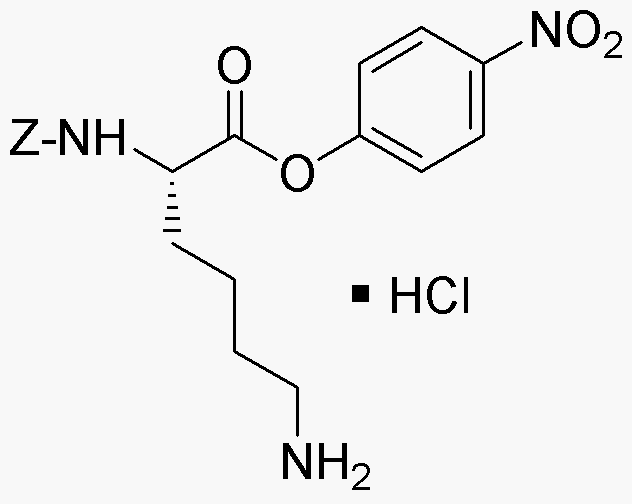Na-Z-L-lysine 4-nitrophenyl ester hydrochloride is widely utilized in research focused on:
- Bioconjugation: This compound serves as a versatile linker in bioconjugation processes, allowing researchers to attach biomolecules like proteins or antibodies to surfaces or other molecules, enhancing drug delivery systems.
- Peptide Synthesis: It is commonly used in the synthesis of peptides, providing a protective group that can be easily removed, thus streamlining the production of complex peptide structures for pharmaceutical applications.
- Drug Development: The compound plays a significant role in the development of new therapeutic agents, particularly in designing prodrugs that improve the bioavailability of active pharmaceutical ingredients.
- Diagnostics: It is utilized in the creation of diagnostic reagents, aiding in the detection of specific biomolecules in clinical samples, which is crucial for disease diagnosis and monitoring.
- Research on Enzyme Activity: This chemical is valuable in studying enzyme kinetics, as it can be used as a substrate in assays to measure enzyme activity, providing insights into metabolic pathways.
Informations générales
Propriétés
Sécurité et réglementation
Applications
Na-Z-L-lysine 4-nitrophenyl ester hydrochloride is widely utilized in research focused on:
- Bioconjugation: This compound serves as a versatile linker in bioconjugation processes, allowing researchers to attach biomolecules like proteins or antibodies to surfaces or other molecules, enhancing drug delivery systems.
- Peptide Synthesis: It is commonly used in the synthesis of peptides, providing a protective group that can be easily removed, thus streamlining the production of complex peptide structures for pharmaceutical applications.
- Drug Development: The compound plays a significant role in the development of new therapeutic agents, particularly in designing prodrugs that improve the bioavailability of active pharmaceutical ingredients.
- Diagnostics: It is utilized in the creation of diagnostic reagents, aiding in the detection of specific biomolecules in clinical samples, which is crucial for disease diagnosis and monitoring.
- Research on Enzyme Activity: This chemical is valuable in studying enzyme kinetics, as it can be used as a substrate in assays to measure enzyme activity, providing insights into metabolic pathways.
Documents
Fiches de données de sécurité (FDS)
La FDS fournit des informations de sécurité complètes sur la manipulation, le stockage et l’élimination du produit.
Spécifications du produit (PS)
Le PS fournit une description complète des propriétés du produit, notamment sa composition chimique, son état physique, sa pureté et les exigences de stockage. Il détaille également les plages de qualité acceptables et les applications prévues du produit.
Certificats d'analyse (COA)
Recherchez des certificats d'analyse (COA) en saisissant le numéro de lot du produit. Les numéros de lot et de lot se trouvent sur l'étiquette d'un produit, après les mots « Lot » ou « Lot de fabrication ».
Numéro de catalogue
Numéro de lot/série
Certificats d'origine (COO)
Ce certificat d'exploitation confirme le pays dans lequel le produit a été fabriqué, et détaille également les matériaux et composants utilisés et s'il est issu de sources naturelles, synthétiques ou autres sources spécifiques. Ce certificat peut être requis pour les douanes, le commerce et la conformité réglementaire.
Numéro de catalogue
Numéro de lot/série
Fiches de données de sécurité (FDS)
La FDS fournit des informations de sécurité complètes sur la manipulation, le stockage et l’élimination du produit.
DownloadSpécifications du produit (PS)
Le PS fournit une description complète des propriétés du produit, notamment sa composition chimique, son état physique, sa pureté et les exigences de stockage. Il détaille également les plages de qualité acceptables et les applications prévues du produit.
DownloadCertificats d'analyse (COA)
Recherchez des certificats d'analyse (COA) en saisissant le numéro de lot du produit. Les numéros de lot et de lot se trouvent sur l'étiquette d'un produit, après les mots « Lot » ou « Lot de fabrication ».
Numéro de catalogue
Numéro de lot/série
Certificats d'origine (COO)
Ce certificat d'exploitation confirme le pays dans lequel le produit a été fabriqué, et détaille également les matériaux et composants utilisés et s'il est issu de sources naturelles, synthétiques ou autres sources spécifiques. Ce certificat peut être requis pour les douanes, le commerce et la conformité réglementaire.


